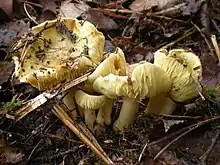Tricholomataceae
The Tricholomataceae are a large family of mushrooms within the Agaricales. Originally a classic "wastebasket taxon", the family included any white-, yellow-, or pink-spored genera in the Agaricales not already classified as belonging to e.g. the Amanitaceae, Lepiotaceae, Hygrophoraceae, Pluteaceae, or Entolomataceae.
| Tricholomataceae | |
|---|---|
 | |
| Tricholoma flavovirens, near Wellfleet, Massachusetts, USA | |
| Scientific classification | |
| Kingdom: | Fungi |
| Division: | Basidiomycota |
| Class: | Agaricomycetes |
| Order: | Agaricales |
| Family: | Tricholomataceae R.Heim ex Pouzar (1983) |
| Type genus | |
| Tricholoma (Fr.) Staude (1857) | |
| Genera | |
|
| |
The name derives from the Greek trichos (τριχος) meaning hair and loma (λωμα) meaning fringe or border, although not all members display this feature.[2]
The name "Tricholomataceae" is seen as having validity in describing Tricholoma and its close relatives, and whatever other genera can at some future point be described as part of a monophyletic family including Tricholoma. To that end, the International Botanical Congress has voted on two occasions (1988 and 2006) to conserve the name "Tricholomataceae" against competing names.[3] This decision does not invalidate the use of segregate families from the Tricholomataceae, but simply validates the continued use of Tricholomataceae.[4]
Taxonomy
Molecular phylogenetic analysis has greatly aided the demarcation of clear monophyletic groups among the Tricholomataceae. So far, most of these groups have been defined cladistically rather than being defined as formal Linnean taxa, though there have been several cases in which older proposed segregates from the Tricholomataceae have been validated by evidence coming from molecular phylogenetics. As of 2006, validly published families segregated from the Tricholomataceae include the Hydnangiaceae, Lyophyllaceae, Marasmiaceae, Mycenaceae, Omphalotaceae, Physalacriaceae, and Pleurotaceae. Arnolds (1986) and Bas (1990) also place the genera of the Hygrophoraceae within this family, but this classification is not accepted by the majority of fungal taxonomists.[5]
In 2014 a study recovers seven monophyletic genera within the Tricholomataceae; Leucopaxillus, Tricholoma, Pseudotricholoma stat. nov, Porpoloma s.str, Dennisiomyces, Corneriella gen.nov. and Albomagister gen. nov.[6] The aim of the study was to delimit the highly polyphyletic Tricholomataceae, and identyfiy monophyletic groups within the Tricholomatoid clade, which includes the families Tricholimoaceae, Entolomataceae, and Lyophyllaceae.[7][8] According to this study there have been several different ways of distributing Porpoloma, which is highly polyphyletic. This study suggests that the genus Porpoloma is distributed in four groups within the Trichlomatatic clade; Porpoloma s.str, Corneriella gen.nov. and Pseudotricholoma stat. nov. and Pogonoloma.
Some species of fungus-growing ants in the genus Apterostigma cultivate species of Tricholomataceae.[9][10]
The extinct genus Archaeomarasmius, described from Turonian-age New Jersey amber,[1] is one of four known genera of Agaricales in the fossil record.[11]
References
- Hibbett, D.S.; Grimaldi, D.S.; Donoghue, M.J. (1997). "Fossil mushrooms from Miocene and Cretaceous ambers and the evolution of Homobasidiomycetes". American Journal of Botany. 84 (8): 981–991. doi:10.2307/2446289. JSTOR 2446289.
- Nilson, Sven; Olle Persson (1977). Fungi of Northern Europe 2: Gill-Fungi. Penguin. p. 24. ISBN 978-0-14-063006-0.
- (Redhead 2003, McNeill, et al. 2006)
- (Young, 2002)
- Young, 2003
- Sánchez-García et al, 2014
- Matheny et al., 2006
- Binder et al.,2010
- Mueller, U. G.; Schultz, T. R.; Currie, C. R.; Adams, R. M.; Malloch, D. (June 2001). "The origin of the attine ant-fungus mutualism". The Quarterly Review of Biology. 76 (2): 169–197. doi:10.1086/393867. ISSN 0033-5770. PMID 11409051.
- Villesen, Palle; Mueller, Ulrich G.; Schultz, Ted R.; Adams, Rachelle M. M.; Bouck, Amy C. (October 2004). "Evolution of ant-cultivar specialization and cultivar switching in Apterostigma fungus-growing ants". Evolution; International Journal of Organic Evolution. 58 (10): 2252–2265. doi:10.1111/j.0014-3820.2004.tb01601.x. ISSN 0014-3820. PMID 15562688.
- Hibbett, D.S.; et al. (2003). "Another fossil agaric from Dominican Amber". Mycologia. 95 (4): 685–687. doi:10.2307/3761943. JSTOR 3761943. PMID 21148976. (subscription required)
- Alexopolous CJ, et al. (2004). Introductory Mycology (4th ed.) Hoboken NJ: John Wiley and Sons. ISBN 0-471-52229-5
- Arnolds E. (1986).
- Bas C. (1990). Tricholomataceae R.Heim ex Pouz. In: Flora Agaricina Neerlandica 2:65. ISBN 90-6191-971-1
- Binder M, Larsson KH, Matheny PB & Hibbett DS (2010). Amylocorticiales ord. nov. and Jaapiales ord. nov.: Early diverging clades of Agaricomycetidae dominated by corticioid forms. Mycologia 102: 865–880. https://dx.doi.org/10.3852/09-288
- Kuo M. (2004).
- Matheny PB, Curtis JM, Hofstetter V, Aime MC, Moncalvo JM, Ge ZW, Slot JC, Ammirati JF, Baroni TJ, Bougher NL, Hughes KW, Lodge DJ, Kerrigan RW, Seidl MT, Aanen D, DeNitis M, Daniel GM, Desjardin,D.E., Kropp, B.R., Norvell, L.L., Parker, A., Vellinga EC, Vilgalys R. & Hibbet DS (2006). Major clades of Agaricales: Amultilocus phylogenetic overview. Mycologia 98: 982–995. https://dx.doi.org/10.3852/mycologia.98.6.982
- McNeill J, Redhead SA, Wiersema JH. (2006). Report of the General Committee: 9. Taxon 55(3):795–800.
- Redhead SA. (2003). (1571) Proposal to conserve the name Tricholomataceae nom. cons. against two additional names, Mycenaceae and Hygrophoraceae (Fungi). Taxon 52(1):135–136.
- Sánchez-García M, Matheny PB, Palfner G, Lodge DG. (2014) Deconstructing the Tricholomataceae (Agaricales) and introduction of the new genera Albomagister, Corneriella, Pogonoloma and Pseudotricholoma. Taxon 63(5): 993–1007.
- Young AM. (2002) Brief notes on the status of Family Hygrophoraceae Lotsy. Australasian Mycologist 21(3):114–116.